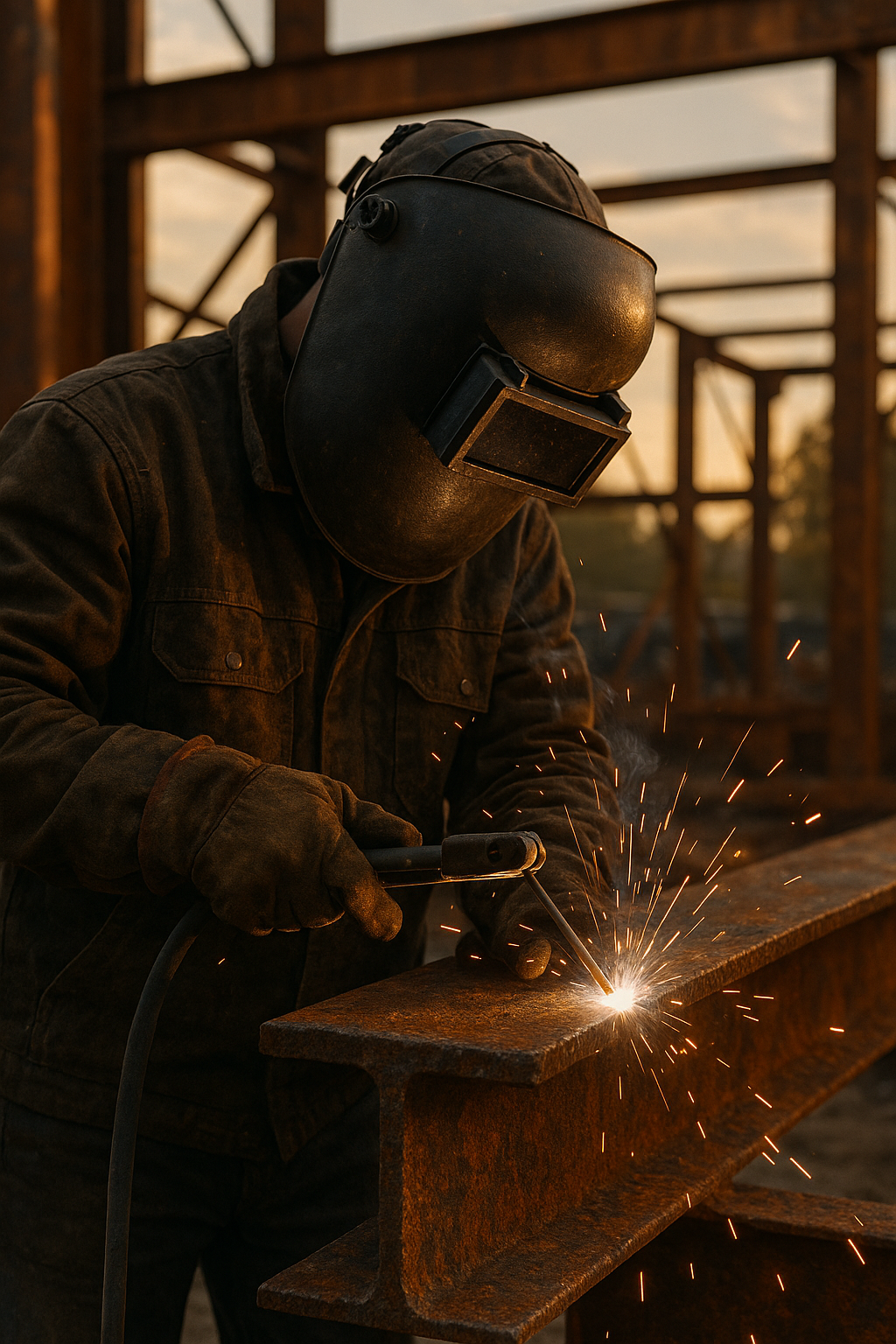Your go-to guide for welding atmospheric corrosion-resistant steel
Introduction
Weathering steel electrodes, especially USA 8018W, are critical tools in structural welding where durability meets the harsh elements. Designed to weld weathering steels like ASTM A588 and A242, these electrodes offer unique properties tailored for outdoor, high-strength applications that require minimal maintenance over decades.
Whether you’re a structural welder, bridge fabricator, or working in heavy equipment repair, understanding the function and behavior of the 8018W classification can mean the difference between a weld that lasts and one that fails in the field.
Types and Classifications
The 8018W designation follows the AWS A5.5 classification for low-hydrogen, iron powder-coated electrodes suited for Shielded Metal Arc Welding (SMAW) of weathering steels.
Here’s how it breaks down:
- “80” = Minimum tensile strength of 80,000 psi
- “1” = All-position usability
- “8” = Low-hydrogen coating, iron powder added
- “W” = Specifically alloyed for weathering steel compatibility
Related Electrode Variants:
- E7018 – General-purpose low-hydrogen rod, not ideal for weathering steel due to mismatched corrosion resistance.
- E8018-C1/Ni1 – Low alloy electrodes with better notch toughness at low temperatures, but lacking in atmospheric corrosion compatibility.
- E8018-W2 – A less common variant with slightly different alloying for specific weathering grades.
Use 8018W when matching weathering steel base metals is essential to prevent premature rusting at the weld zone.
Key Characteristics and Properties
8018W electrodes are engineered with a blend of nickel, copper, and chromium, matching the alloying elements in weathering steels. These additions promote a stable oxide layer—the patina—that protects the weld from further corrosion.
Technical Specs:
| Property | Value / Description |
|---|---|
| Tensile Strength | ≥ 80,000 psi (550 MPa) |
| Yield Strength | Typically ≥ 67,000 psi (460 MPa) |
| Elongation | ≥ 22% in 2 inches |
| Impact Toughness (avg) | ≥ 20 ft-lbs @ -20°F (-29°C) |
| Coating Type | Low-hydrogen, iron powder |
| Typical Alloy Additions | Cu, Ni, Cr |
| Storage Requirement | <4% moisture, keep in rod oven at 250°F+ |
💡 Real-World Insight:
When left unpainted in bridges or sculptures, the weld must weather at the same rate as the surrounding metal. If a standard rod is used, you’ll see rust bleed or cracking at the joint after a few freeze/thaw cycles.
Process Considerations
USA 8018W is used exclusively in SMAW (Stick) welding and performs well across all positions, including vertical and overhead.
Process Notes:
- Polarity: DCEP (Direct Current Electrode Positive)
- Amperage Range: ~90–150 A (3/32″ to 1/8″ diameter)
- Preheat & Interpass: 100–200°F depending on base metal thickness
- Rod Oven Use: Mandatory – keep at 250°F to avoid moisture-induced cracking (hydrogen embrittlement)
Equipment Compatibility:
- Compatible with any SMAW-capable machine (inverter or transformer)
- Good arc stability and puddle control, even on aged, weathered base material
- Can be used with basic clamps and leads; no special feeder systems needed
Challenges:
- Storage sensitivity: Moisture pickup leads to serious weld defects
- Slag coverage: Heavy slag, can mask undercut or porosity if not properly cleaned between passes
- Arc strikes: Can cause localized corrosion if not properly grounded out
Application Use Cases
8018W electrodes are purpose-built for use on structural weathering steel, where long-term atmospheric resistance is a must without the use of paint or coating.
Industries & Projects:
- Bridges & overpasses (e.g., Corten steel bridges)
- Architectural facades with exposed steel elements
- Railcars and shipping containers
- Transmission towers
- Outdoor sculptures and public installations
Why it’s ideal:
- Weld metal forms a matching patina with the base metal
- High mechanical strength for structural loads
- Resists cracking and hydrogen-induced failure
- Eliminates the need for painting or regular maintenance
Best Practices & Pro Tips
Practical Tips for Welders:
- Rod Storage: Keep in a 250°F rod oven. Don’t trust rods left out overnight in humid shops.
- Joint Design: Use backing bars or preheats for thick sections to prevent root cracking.
- Slag Removal: Use a chipping hammer or needle scaler between passes—slag is tough and can trap inclusions.
- Arc Strikes: Always grind out stray strikes. Weathering steel will corrode unevenly around them.
- Weld Appearance: Don’t chase perfect beads—focus on soundness and coverage, especially on multi-pass welds.
Pro Insight:
If you’re welding a Corten beam on a high-visibility project (like sculpture or facade), your 8018W welds will age with the metal and virtually disappear after a few seasons. Just don’t expect that if you use a 7018.
Conclusion
USA 8018W electrodes are a specialized but essential choice for welding weathering steel structures. Their ability to match the corrosion resistance and aesthetic of the base metal makes them irreplaceable in applications where appearance and durability both matter.
If you’re welding outdoors on structural steel that’s designed to rust intentionally, don’t wing it with a standard rod. Stick with 8018W. It’s the right tool for the job, and your welds will last as long as the steel they’re holding together.
- ANSI/AWS A5.5 E8018- W2 ASME SFA 5.5 E8018- W2
- 10 LB Package – 8018-W
- 1/8″ Stick Electrode
- Tensile Strength (psi) 80,000
- Yield Strength (psi) 67-80,000
Last update on 2025-12-05 / Affiliate links / Images from Amazon Product Advertising API
Note: Some links on this page may be affiliate links. If you click and make a purchase, we may earn a commission at no extra cost to you. We only recommend products we trust and use in the field.



Leave a Reply